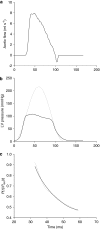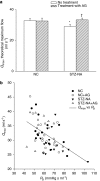Aminoguanidine prevents the impairment of cardiac pumping mechanics in rats with streptozotocin and nicotinamide-induced type 2 diabetes
- PMID: 18376420
- PMCID: PMC2439860
- DOI: 10.1038/bjp.2008.119
Aminoguanidine prevents the impairment of cardiac pumping mechanics in rats with streptozotocin and nicotinamide-induced type 2 diabetes
Abstract
Background and purpose: Aminoguanidine (AG), an inhibitor of advanced glycation endproducts, has been shown to prevent arterial stiffening and cardiac hypertrophy in streptozotocin (STZ) and nicotinamide (NA)-induced type 2 diabetes in rats. Our aims were to examine whether AG produced benefits on cardiac pumping mechanics in the STZ and NA-treated animals in terms of maximal systolic elastance (E(max)) and theoretical maximum flow (Q(max)).
Experimental approach: After induction of type 2 diabetes, rats received daily injections of AG (50 mg kg(-1), i.p.) for 8 weeks and were compared with age-matched, untreated, diabetic controls. Left ventricular (LV) pressure and ascending aortic flow signals were recorded to calculate E(max) and Q(max), using the elastance-resistance model. Physically, E(max) reflects the contractility of the myocardium as an intact heart, whereas Q(max) has an inverse relationship with the LV internal resistance.
Key results: Both type 2 diabetes and AG affected E(max) and Q(max), and there was an interaction between diabetes and AG for these two variables. The E(max) and Q(max) were reduced in rats with type 2 diabetes, but showed a significant rise after administration of AG to these diabetic rats. Moreover, the increase in Q(max) corresponded to a decrease in total peripheral resistance of the systemic circulation when the STZ and NA-induced diabetic rats were treated with AG.
Conclusions and implications: AG therapy prevented not only the contractile dysfunction of the heart, but also the augmentation in LV internal resistance in rats with STZ and NA-induced type 2 diabetes.
Figures



Similar articles
-
Acetyl-l-carnitine and oxfenicine on cardiac pumping mechanics in streptozotocin-induced diabetes in male Wistar rats.PLoS One. 2013 Jul 26;8(7):e69977. doi: 10.1371/journal.pone.0069977. Print 2013. PLoS One. 2013. PMID: 23922880 Free PMC article.
-
Systolic elastance and resistance in the regulation of cardiac pumping function in early streptozotocin-diabetic rats.Exp Biol Med (Maywood). 2002 Apr;227(4):251-9. doi: 10.1177/153537020222700405. Exp Biol Med (Maywood). 2002. PMID: 11910047
-
Aminoguanidine prevents arterial stiffening in a new rat model of type 2 diabetes.Eur J Clin Invest. 2006 Aug;36(8):528-35. doi: 10.1111/j.1365-2362.2006.01672.x. Eur J Clin Invest. 2006. PMID: 16893374
-
Aminoguanidine prevents fructose-induced deterioration in left ventricular-arterial coupling in Wistar rats.Br J Pharmacol. 2007 Jun;151(3):341-6. doi: 10.1038/sj.bjp.0707223. Epub 2007 Apr 2. Br J Pharmacol. 2007. PMID: 17401443 Free PMC article.
-
Model of Streptozotocin-nicotinamide Induced Type 2 Diabetes: a Comparative Review.Curr Diabetes Rev. 2022;18(8):e171121198001. doi: 10.2174/1573399818666211117123358. Curr Diabetes Rev. 2022. PMID: 34789130 Review.
Cited by
-
Panax notoginseng Saponin Protects Against Diabetic Cardiomyopathy Through Lipid Metabolism Modulation.J Am Heart Assoc. 2022 Feb 15;11(4):e023540. doi: 10.1161/JAHA.121.023540. Epub 2022 Feb 3. J Am Heart Assoc. 2022. PMID: 35112884 Free PMC article.
-
Role of Changes in State of Bound Water and Tissue Stiffness in Development of Age-Related Diseases.Polymers (Basel). 2020 Jun 17;12(6):1362. doi: 10.3390/polym12061362. Polymers (Basel). 2020. PMID: 32560459 Free PMC article. Review.
-
The AGE-RAGE Axis: Implications for Age-Associated Arterial Diseases.Front Genet. 2017 Dec 5;8:187. doi: 10.3389/fgene.2017.00187. eCollection 2017. Front Genet. 2017. PMID: 29259621 Free PMC article. Review.
-
Carbonylation of myosin heavy chains in rat heart during diabetes.Biochem Pharmacol. 2010 Jul 15;80(2):205-17. doi: 10.1016/j.bcp.2010.03.024. Epub 2010 Mar 30. Biochem Pharmacol. 2010. PMID: 20359464 Free PMC article.
-
Diabetic cardiomyopathy: bench to bedside.Heart Fail Clin. 2012 Oct;8(4):619-31. doi: 10.1016/j.hfc.2012.06.007. Epub 2012 Aug 9. Heart Fail Clin. 2012. PMID: 22999244 Free PMC article. Review.
References
-
- Avigad G, Kniep A, Bailin G. Reaction of rabbit skeletal myosin with D-glucose 6-phosphate. Biochem Mol Biol Int. 1996;40:273–284. - PubMed
-
- Baynes JW, Thrope SR. Role of oxidative stress in diabetic complications. A new perspective on an old paradigm. Diabetes. 1999;48:1–9. - PubMed
-
- Bidasee KR, Nallani K, Yu Y, Cocklin RR, Zhang Y, Wang M, et al. Chronic diabetes increases advanced glycation end products on cardiac ryanodine receptors/calcium-release channels. Diabetes. 2003;52:1825–1836. - PubMed
-
- Bidasee KR, Zhang Y, Shao CH, Wang M, Patel kp, Dincer ÜD, et al. Diabetes increases formation of advanced glycation end products on sarco(endo)plasmic reticulum Ca2+-ATPase. Diabetes. 2004;53:463–473. - PubMed
-
- Brown MR, Knull HR. Effects of nonenzymatic glycation of subfragment-1 of myosin on interaction with actin. Biochem. Cell Biol. 1992;70:617–622. - PubMed
Publication types
MeSH terms
Substances
LinkOut - more resources
Full Text Sources
Medical

